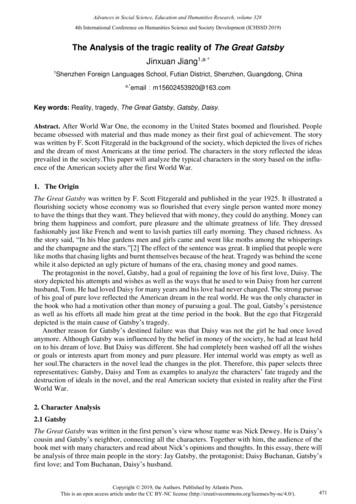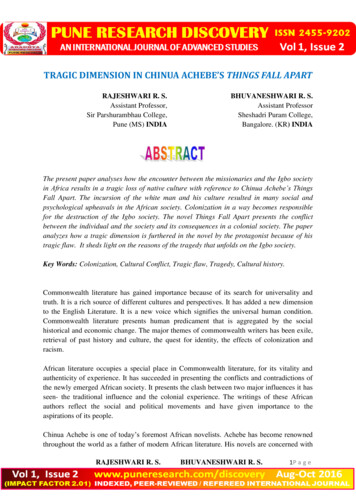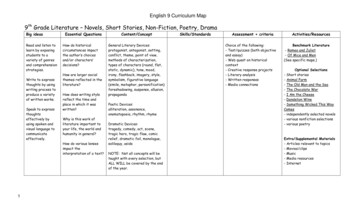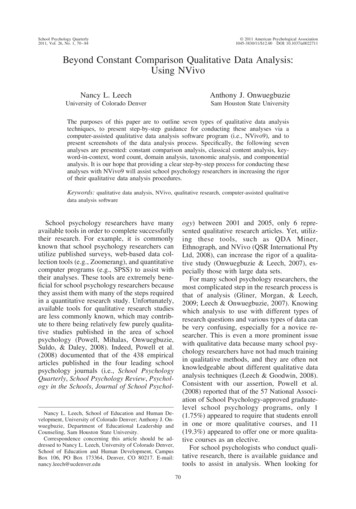
Transcription
Advances in Social Science, Education and Humanities Research, volume 3284th International Conference on Humanities Science and Society Development (ICHSSD 2019)The Analysis of the tragic reality of The Great GatsbyJinxuan Jiang1,a,*1Shenzhen Foreign Languages School, Futian District, Shenzhen, Guangdong, Chinaa,*email:m15602453920@163.comKey words: Reality, tragedy, The Great Gatsby, Gatsby, Daisy.Abstract. After World War One, the economy in the United States boomed and flourished. Peoplebecame obsessed with material and thus made money as their first goal of achievement. The storywas written by F. Scott Fitzgerald in the background of the society, which depicted the lives of richesand the dream of most Americans at the time period. The characters in the story reflected the ideasprevailed in the society.This paper will analyze the typical characters in the story based on the influence of the American society after the first World War.1. The OriginThe Great Gatsby was written by F. Scott Fitzgerald and published in the year 1925. It illustrated aflourishing society whose economy was so flourished that every single person wanted more moneyto have the things that they want. They believed that with money, they could do anything. Money canbring them happiness and comfort, pure pleasure and the ultimate greatness of life. They dressedfashionably just like French and went to lavish parties till early morning. They chased richness. Asthe story said, “In his blue gardens men and girls came and went like moths among the whisperingsand the champagne and the stars.”[2] The effect of the sentence was great. It implied that people werelike moths that chasing lights and burnt themselves because of the heat. Tragedy was behind the scenewhile it also depicted an ugly picture of humans of the era, chasing money and good names.The protagonist in the novel, Gatsby, had a goal of regaining the love of his first love, Daisy. Thestory depicted his attempts and wishes as well as the ways that he used to win Daisy from her currenthusband, Tom. He had loved Daisy for many years and his love had never changed. The strong pursueof his goal of pure love reflected the American dream in the real world. He was the only character inthe book who had a motivation other than money of pursuing a goal. The goal, Gatsby’s persistenceas well as his efforts all made him great at the time period in the book. But the ego that Fitzgeralddepicted is the main cause of Gatsby’s tragedy.Another reason for Gatsby’s destined failure was that Daisy was not the girl he had once lovedanymore. Although Gatsby was influenced by the belief in money of the society, he had at least heldon to his dream of love. But Daisy was different. She had completely been washed off all the wishesor goals or interests apart from money and pure pleasure. Her internal world was empty as well asher soul.The characters in the novel lead the changes in the plot. Therefore, this paper selects threerepresentatives: Gatsby, Daisy and Tom as examples to analyze the characters’ fate tragedy and thedestruction of ideals in the novel, and the real American society that existed in reality after the FirstWorld War.2. Character Analysis2.1 GatsbyThe Great Gatsby was written in the first person’s view whose name was Nick Dewey. He is Daisy’scousin and Gatsby’s neighbor, connecting all the characters. Together with him, the audience of thebook met with many characters and read about Nick’s opinions and thoughts. In this essay, there willbe analysis of three main people in the story: Jay Gatsby, the protagonist; Daisy Buchanan, Gatsby’sfirst love; and Tom Buchanan, Daisy’s husband.Copyright 2019, the Authors. Published by Atlantis Press.This is an open access article under the CC BY-NC license 71
Advances in Social Science, Education and Humanities Research, volume 328Being the title of the book tells us, Jay Gatsby is the protagonist of the story and his goal is to win thelove of Daisy back from Tom Buchanan. He and Daisy met five years before the start of the story andGatsby was deeply in love with the beautiful and innocent young girl. His attempt failed and eventually he was killed. There are several reasons for his failure and tragedy. The first one was his wrongattempt at winning Daisy back. Although his goal was purely about love and his devotion in his goalwas considered great, Daisy, the girl he so deeply in loved with, was not the innocent girl five yearsago. She was deeply affected by the trend of society to chase money and material. Gatsby’s dream ofpure love had already shattered, like the shattered American dream at that time. It was an analogy. Inthe past, the American dream was that someone could achieve his or her own dream by hard workand devotion and focus on one single goal. And the dream was to develop a person’s interest andfocus on one goal that can help the person become the best of himself. Gatsby’s past with Daisy wasthe reflection of the American dream. He and Daisy had a wonderful time together and the pure lovebetween them was like the single-minded goal a person with dream had. However, the ‘dream’ at thetime of the story took place was to gain as much money as one can. People viewed money as powerand the god that could do anything. There was no goal existed at that time to be called an Americandream. For the reason above, Gatsby could not possibly achieve his goal at the beginning because his‘goal’ did not actually exist any more.Another reason for Gatsby’s failure was that he used the wrong method to win back Daisy. Anotherreason for Gatsby’s failure was his self-lost. The background of the novel was in the 1920s, showinga furious “Jazz Time”. The amount of wealth became the criterion for judging a person's success.People began to make money and pursue wealth blindly and irrationally. At the same time, hedonism,Spencer's theory of evolution and James' pragmatic philosophy began to prevail.Gatsby was born tobe humble with courage and luck to became a rich man.Gatsby firmly pursued his dream: the materialbasis of money, fame and fortune in exchange for the spiritual pursuit of lost love. When Nick wentto his house for the first time, he was arranging a large party in his house and invited lots of famouspeople to the party. His goal of the arrangement was the hope that Daisy would accidentally went inand they could meet each other. There are lines in the story that revealed his richness as well as theluxury of the party, “On buffet tables, garnished with glistening horsd’oeuvre, spiced baked hamscrowded against salads of harlequin designs and pastry pigs and turkeys bewitched to a dark gold.”[2]From the description of the food provided for the party, Gatsby’s richness could be seen easily andknowing his goal of winning back Daisy, his attitude towards money could also be detected. He believed that money could bring him many things that he wanted, including Daisy. And he stronglybelieved that money was the reason why he could not marry Daisy or win her love. That’s why hearrange the grand party to show his richness and thus attract Daisy’s attention back. From Gatsby’sattitude towards money, we could find out that he was also influenced by the ideas of the society atthat time, which made his tragedy definite and sad. The effect of the ideas of society on Gatsby canbe further revealed by his own words towards Daisy, “Her voice is full of money.”[2] Deep in hismind, Gatsby had already known that Daisy was poisoned by materialism and that if she went backto him, it was not for love but for his money. But Gatsby did not care. Because he himself believethat money could bring back anything that he wanted, even the wonderful past that had already beenshattered and did not exist any more. The efforts that he made and the persistence that he had madehim great, but the ignorance and the belief in money assured his failure and his ultimate death. Thedecline of morality was also implied in his action. Although the act of winning back the first loveback may seemed courageous and approving, Gatsby was actually making a mistake. No matter Daisyloved Tom Buchanan or not, she had married him. The fact could not be changed and that if Gatsbystepped in, he would be the one who was lack of morality. He thought he was making the right choiceof bringing Daisy love and happiness, but he was actually breaking an exist family from all aspectsviewed.2.2 DaisyDaisy was the most important character other than Gatsby in the story. She was Gatsby’s first love aswell as his goal and was the reason why the story happened. Her name, Daisy, originally means a472
Advances in Social Science, Education and Humanities Research, volume 328kind of beautiful flower with a yellow disc and white rays. The flower revealed innocence and beauty.Daisy was definitely beautiful as well as charming. Her voice was described as “the kind of voicethat the ear follows up and down, as if each speech is an arrangement of motes that will never beplayed again.”[2] Her voice made man excited and the exciting things would “hover in the nexthour.”[2] A sharp contrast to her charming voice was the emptiness of the content of her talks and itwas because her mental world was nearly empty. Her words were even untrue or overemphasizing.When she was talking to Nick, she said that “you remind me of a rose, an absolute rose.”[2] Nickhimself did not think that he was “faintly like a rose.”[2] But as she was a lovely creature, the charming power of hers conceal out the effect of her words. Her focus was always on trivial things. DuringDaisy and Gatsby’s first meeting after five years’ departure, Gatsby took her and showed her aroundthe house. When they went into a room with portraits and photographs, Daisy pointed at the pictureof Gatsby in yachting costume and said she adored the picture and said that he never told her he hada pompadour or a yacht. In her words, it could be discovered that what Daisy focused on was appearance of Gatsby, and his money of probably owning a yacht. She seemed to be a friendly and cutecreature by looking at the scene in which she talked happily and enthusiastically with Nick or Jorden,she was actually cold in emotion. She did not care about Tom Buchanan of having another womanapart from her, his wife. She had already known the fact and did not try to stop Tom, which revealedthe fact that she did not love Tom. So why did she marry him? Daisy’s life was filled with desire formoney and material. As a result, there was only one reason for her act of marrying Tom Buchanan:money. Also, being Gatsby’s first love and after all Gatsby had done for her, she approved of Tom’sact of making Gatsby the cause of the accident of killing Myrtle. She went back to Tom after theaccident and agreed to Tom’s plan of telling George Wilson, Myrtle’s husband, Gatsby was the murderer. Then she fled with Tom and did not even attend Gatsby’s funeral. Furthermore, Daisy’s uglynature was implicitly revealed when she went to Gatsby’s house for the first time. Gatsby took all hisshirts out and Daisy started crying. She started to say that she never saw so many beautiful shirts. Thescene showed Daisy’s envy towards Gatsby of owning such an amount of money. Also, as whatGatsby had said, “her voice is full of money.”[2] When the weather was too hot to stand, Daisy urgedher friends to have some fun. She thought they should do something that afternoon, “and the day afterthat, and the next thirty years.”[2] Then she pleaded they all went to town “on the verge of tears.”[2]When they finally decided to go, she urged someone to smoke a cigarette first because it was “toohot to fuss.”[2] All the talks and actions of Daisy above implicitly revealed her mental world andthoughts about life. Her life was empty and boring and she hated that, which could be seen by herbeing “on the verge of tears”[2] when no one seemed to agree to her plans. In order to fill her life,Daisy must did her best to seek something and make choices, and she chose ‘fun,’ that is, pleasure.And her talks about having fun suggested her ideas about what was fun. Smoking and going to townfor shopping or parties. The things that she chose was strongly related to material and money and wasalso empty. Smoking made a person forget about their sadness or worry for a short period of time butcould do nothing to solve problems, and shopping illustrated the desire of material things. What’smore, because Daisy did not have any goal for herself, she could only fill her life with the seek ofpure pleasure. But for all the character flaws that she had, Daisy was also a tragic figure. She livedan empty life with pleasure generated from material as a shell. When she gave birth to she and Tom’schild, Tom was no where to be found and she was alone and had feeling of being abandoned. Shethought everything was terrible and every one thought like her. The emotion and thoughts inside herheart revealed when she talked to Nick, “You see I think everything’s terrible anyhow. Everybodythinks so-the most advanced people. And I know. I’ve been everywhere and seen everything and doneeverything. Sophisticated—God, I’m sophisticated!”[2] At the point, it was reasonable to suspect thatDaisy was aware of what the society was like and her position in it. She was aware of her own situation and the “laugh with thrilling scorn”[2] was probably aimed at herself.2.3 TomTom Buchanan was Daisy’s husband and a antagonist in the story because he was the main force thatprevented Gatsby from achieving his goal. He was a harsh and evil person who was lack of morality473
Advances in Social Science, Education and Humanities Research, volume 328and proper virtue. When George Wilson was trying his best to make money and wanted to buy hiscar, Tom refused when he heard the request. Also, when his wife, Daisy, was about to give birth, hedid not fulfill his responsibility as a husband and accompany his wife. On the contrary, he foundanother woman who was the wife of Wilson and had secret relationship with her. Instead of feelingguilty or regret for his action, he even disdained Wilson when he said that Wilson did not have thefaintest idea his wife had another man and thought she visited her relative every time she went awayby train. When Nick asked if Wilson objected their meetings, Tom said “He’s so dumb he doesn’tknow he’s alive,”[2]which was a harsh thing to say and it could be detected that Tom was laughingat him even if he was the one that lack of morality. He did not think he did anything wrong and eventhought that he was doing Myrtle a favor when he said “It does her good to get away.”[2] It was clearthat Tom made his action of morally good. He viewed himself as a person who was helping a miserable woman to get away from her dumb husband while he himself was never better than Wilson inany way of thinking. Furthermore, Tom was a bad racist. He thought that white people were the onesthat were building civilization. During Nick’s first visit, he said that “It’s up to us, who are the dominant race, to watch out or these other races will have control of things,”[2] which made his racismobvious. What’s more, he was the direct cause of Gatsby’s death. When Gatsby admitted the accidentthat was not done by him, Tom did not had the slightest feeling of gratitude towards him of savinghis wife’s life, instead, Tom told Wilson secretly that Myrtle was murdered by Gatsby. Wilson wasin rage and shot Gatsby and then killed himself after that. Like Daisy, Tom did not attend Gatsby’sfuneral after all Gatsby had done for protecting his wife. He did not show respect to him and did nothave any sympathy towards him. As he said “Money is a toy of luxury life,”[2] Moral corruption,Material desire, Class, racial and gender discrimination completely occupied all of his mind.3. Reason of society behind the novelThe Great Gatsby illustrated a world filled with the chase for enjoyment and material, and it seemedthat the goal for many people, like Wilson in the story, was to gain more money. The poor was working hard and the rich was showing off. The society showed an air of prosperity and lives of peopleseemed dissipated. The reason behind the prosperity of the society in the book could be find in theworld in which the writer Fitzgerald lived, and that was the time period after World War One.During World War One, the nation lent large amount of money during wartime and that it was thetime that those countries must pay had money paid it back. Furthermore, being the country that wonthe war, the defeated countries must pay money for the damage that the war made. Thus, Americawas possibly the richest and the least damaged country in the world after the war.The money gained in the above way and through selling weapons and supplies, America in thepostwar years became a country with booming economy. With the second industrial revolution,productivity increased and new technologies, like the use of oil and electricity, were adopted. Technologies changed people’s way of life. Cars emerged as a popular kind of transportation. By the endof the 1920s, there was an average of nearly one car per American family.[1]New ideas also went in America all over the world and challenged the traditional ideas. The diligence, thrift and abstinence advocated by the pre-war traditional Puritanism values gradually turnedinto a consumption-centered form.[1] Girls began to wear short skirts above their knees instead oflong trousers that could cover their legs entirely. And because of the bloody war, many people whofirmly carried the traditional ideas died, and the obstacles toward new lives were moved. People’slives, new ideas about consuming goods or the ways of living also changed dramatically. New kindsof entertainment appeared, like radio and movie. People from different parts of the country couldlisten to the same programs on videos, such as sports event, operas and comedies. And going to watchmovies had became a national habit in cities, suburbs and small towns. These emerging popular cultures have reshaped American urban culture, lifestyle and family values.[1]The booming economy as well as the introduction and invention of new things took Americans toan age of enjoyment and the strong belief of money. Money became the sole goal for many people inthe United States, and material became the seek. However, it was a period that the rich people becamericher, and the poor men became poorer. Business men were making considerable amounts of money474
Advances in Social Science, Education and Humanities Research, volume 328and farmers were living hard lives because the price of goods dropped. The huge gap existed betweenthe two kinds of people. The Americans could not achieve the dream of gaining status and moneythrough hard work any more, which was one of the theme in the Great Gatsby.4. ConclusionThe society that Fitzgerald lived in shaped his story the Great Gatsby. The flourished economy of thepostwar years leading to the growth of industrial development and thus creating the tendency of chasing material and money. Influenced by the extravagant life of the new era, Fitzgerald used the reallife as background to create a story, in which multiple characters with approximately the same problems were presented: Daisy, Tom, Gatsby, George, etc. Even Gatsby in the story had the problem ofplacing money on a place that was too important in his life. He thought that money could bring himanything, including his lost love Daisy. Daisy and Tom were two typical characters who loved moneymore than anything in their lives. Daisy’s talk was “full of money,” [2] and Tom had the same thoughtas Gatsby, though he was more arrogant and selfish.Using the characters above and the likes of them, Fitzgerald implicitly revealed the feature of thesociety and implied on Gatsby about the past of America. Fitzgerald's socially-oriented novel reflected American society in which social customs and moral values have changed dramatically. TheGreat Gatsby depicted the real tragedy of the lost characters in the feast and luxury world. The characters and dreams under the distorted social and moral values inevitably shattered in the cold andcruel reality.References[1] John J. Newman and John M. Schmalbach, AMSCO, First Figs from Thistles, pp.473, 474, 475,477, 1922.[2] F. Scott Fitzgerald, The Great Gatsby, Scribener, pp.40, 120, 9, 14, 118, 119, 17, 26, 13, 2004.475
2.1 Gatsby The Great Gatsby was written in the first person's view whose name was Nick Dewey. He is Daisy's cousin and Gatsby's neighbor, connecting all the characters. Together with him, the audience of the book met with many characters and read about Nick's opinions and thoughts. In this essay, there will










